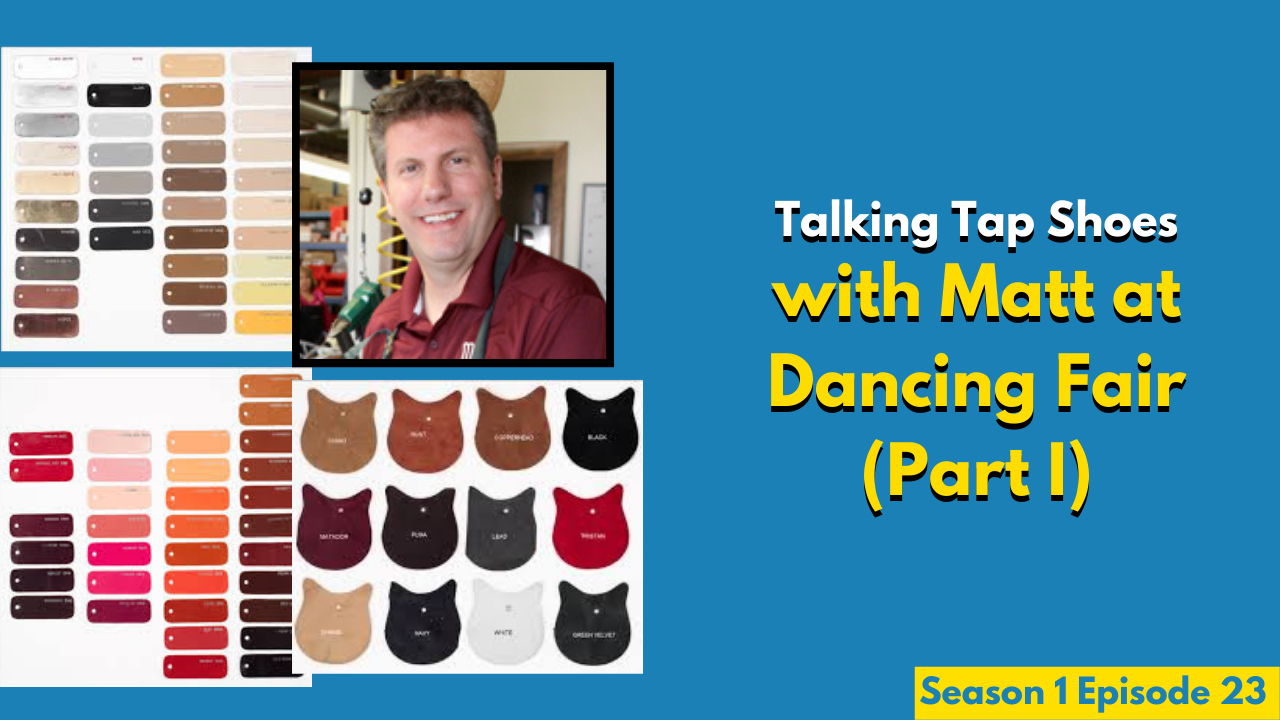Matt at Dancing Fair Talks Tap Dance Shoes (Part 1)

Published on April 10th 2019 by Hillary-Marie
Our guest today is the tap shoe man himself, Matt Schroepfer, from Dancing Fair in Minneapolis, MN.
HM: Can you tell us about the journey of Dancing Fair and how you became the “go-to guy” for custom tap shoes? (1:00)
MS: In 1955, Matt’s father started a shoe and clothing department store, which included a dance department. His father had a background in orthopedic footwear, which allowed him to help dance teachers, specifically, who were having foot and shoe problems. In the mid-80s, his father was looking to retire, so Matt decided to go into business with him, and decided to take the store and focus solely on dance footwear. Dancing Fair sells all styles of dance shoes from pointe, to character and of course, tap shoes. The business has grown by listening to dancers and their needs and we can offer them a product that allows them to perform their best.
Side note: It is so important that we support small, family businesses!
HM: Can you tell us about the journey in creating your Matteo GS1 (the shoe I wear)? (5:40)
MS: Matt carried on the family tradition in orthopedic footwear and went back to school (Scholl College of Podiatric Medicine) and obtained his Certification in Pedorthics (like a shoe doctor) because he wanted to create dance shoes that were more comfortable and healthier for the dancer. Matt looked at the shoes that were on the market and noticed they weren’t working for many dancer, and he set forth to create a shoe that fit the needs of the dancers. He worked with Nick Bowman of Rhythmic Circus, a professional tap company in the Twin Cities, to create this shoe, which has the flexibility and comfort Nick was looking for, but also the functionality he was looking for while achieving fantastic sound. Matt is currently working on a new shoe last, because not every foot shape is the same.
HM: What are the most popular shoe modifications in terms of Pedorthics or Orthotics that you find common amongst tap dancers? (10:28)
MS: Leg length discrepancy is common, so Matt often adds extra depth to a shoe to accommodate for this discrepancy. He is also able to add extra space inside the shoe the allow for orthotics that the dancer may need to wear in the shoe. Matt also adds a Metatarsal Bar, which is a strip of leather which is lined over the top of the ball of the foot to keep the foot flat and leather, taking the pressure off of the ball of the foot. A leather or rubber half-sole is sometimes added to fill the gap in the shoe. Matt also shows dancers how to lace their shoes using lock-laces that prevent heel slippage. They are also able to add length or width, stretch your shoes for bunions and bumps.
HM: What are the different ways a dancer can customize their tap shoes? (14:50)
MS: Sole builds and heels builds are very common customizations. The GS1 has a small wedge at the toe that adds extra thickness to use a longer screw for a solid tap mount, and adds a little weight at the toe tap. It is also flexible enough to provide some comfort for your joints.
For the K360s, Matt often does a Tap Pro Build, or double sole, or even a Triple Sole Build. Matt often adds to the build of the heel with double and triple builds so the shoe stays in balance. He notes that the more soles, the heavier the shoe, which some dancers want, but those heavier shoes can cause problems down the road on your joints.
HM: Let’s talk shank vs. no shank (20:15)
MS: A shank is a piece of material, normally steel, that Matt sandwiches in between the insole and the outsole. It makes the shoe stiff and rigid. When the shank is removed, there is some flex in the arch of the shoe. Miller and Ben shoes have a steel shank which makes the shoe very rigid and heavy. The GS1s do not have a steel shank, so there is some flex in the arch which becomes more flexible and softens over time with heat, moisture and wear. Matt can also manipulate the shank and add partial or short shanks, uses other materials in place of the steel such as plastic or a more flexible material.
Join us for next week for Part 2 of this interview where Matt dives deep into different leather options and different types of taps, including aluminum, steel and wooden taps, and much more.

